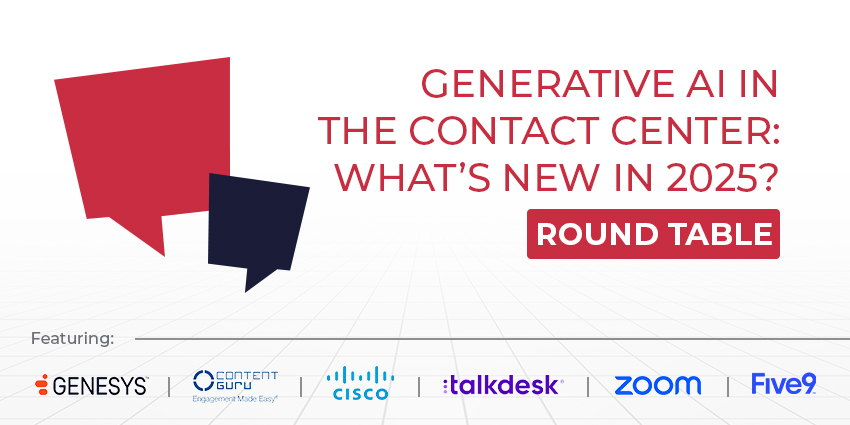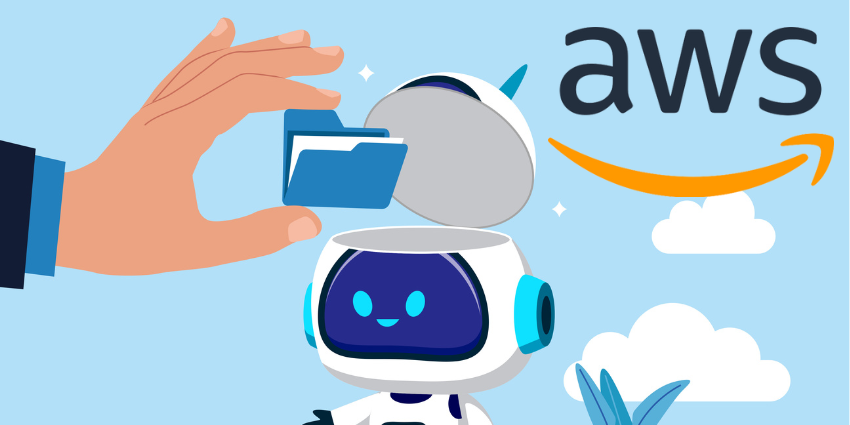As contact centers experiment with generative AI (GenAI), they’re moving from promising pilot projects to full-scale deployments.
These deployments are slowly reshaping how agents work, how leaders drive contact center efficiency, and how customers engage.
This roundtable unpicks the latest advancements shaping GenAI in the contact center and what innovations lie ahead for brands looking to stay ahead of the curve.
The industry experts participating this month include:
- Amy Roberge, Head of Global Contact Center Solution Engineering at Zoom
- Martin Taylor, Co-Founder and Deputy CEO of Content Guru
- Jay Patel, SVP and GM, Webex Customer Experience Solutions at Cisco
- Thomas John, VP EMEA at Five9
- Mike Szilagyi, SVP/ GM Product Management at Genesys
- Crystal Miceli, Vice President of Product and Industry Marketing at Talkdesk
Below, they share emerging use cases, challenges, and predictions for GenAI in contact centers.
Emerging Use Cases of Contact Center GenAI
Next-Generation Virtual Agents
Roberge: In 2025, the contact center is entering a new era of intelligence, one in which AI isn’t just generating responses; it’s taking action.
As this shift takes hold, virtual agents will move from static flows to autonomously completing tasks like order updates, appointment changes, or data retrieval.
However, automation alone isn’t enough. When escalation is necessary, human agents step in, and they must be just as empowered.
Thankfully, real breakthroughs are happening at the intersection of agentic AI and agent assist, supporting agents as they engage in complex, emotionally-charged conversations.
The future of CX isn’t AI vs. human; it’s AI setting the pace and humans delivering the finish.
Automated AI Quality Management
Taylor: Whether scoring for CSAT, empathy, or regulatory adherence, Auto QM is redefining the speed and scale at which contact centers can evaluate customer conversations.
Instead of sampling a handful of interactions, AI can audit 100 percent of calls and messages almost instantly, flagging risks and surfacing coaching opportunities in real time.
This shift transforms the auditor’s role from a highly-paid finder of call recordings to someone delivering real value, spotting trends, improving processes, and driving performance.
For the agent, it replaces the dreaded, delayed performance review with almost instant, constructive feedback that supports continuous improvement.
Auto QM isn’t just faster; it’s fairer, more consistent, and allows quality teams to focus on what matters: enabling better experiences for customers and agents.
Real-Time Agent Assist
John: One of the most impactful emerging use cases for generative AI in contact centers is real-time agent assist.
Businesses are leveraging GenAI to surface contextual prompts, suggest next-best actions, and summarize interactions on the fly.
Indeed, 94 percent of business leaders are using AI to support agents live during customer interactions, per a recent Five9 survey.
Ultimately, that not only boosts productivity but also empowers agents to focus on complex, emotionally charged issues, where empathy and human judgment matter most.
In this sense, GenAI helps bridge the gap between speed and quality in service delivery.
Advanced Contact Center Reporting
Miceli: GenAI has revolutionized how contact centers create, manage, and deliver customer service.
GenAI supported self-service use cases using natural language, serving up just-in-time knowledge to agents.
Additionally, it improved contact center reporting, enabling supervisors and administrators to pull themes and opportunities for improvement from call recordings and transcripts.
The next wave of AI innovation that is taking hold in 2025 is agentic AI.
Now, the most innovative contact center solutions include not just agentic AI but also multi-agent orchestration in an end-to-end platform.
With multiple agents, brands can deploy a network of AI agents, each with a specific specialty, to collaborate and solve advanced customer queries.
Automating Routine Agent Tasks
Patel:
Generative AI first helped agents by automating note-taking, drafting customer responses, and automating after call work (ACW).
Now, AI agents are taking it one step further by automating routine queries, allowing human agents to focus on more complex, high-value inquiries.
These agents act as a 24/7 front door to a business – available across any channel, whether voice or digital – ensuring it can meet customers wherever they are.
Recent advancements in generative AI have enabled more natural, human-like interactions, delivering a truly conversational AI experience.
The ability to process and analyze vast amounts of data drives more personalized and accurate interactions at scale.
Additionally, integrating “agentic AI”, which combines workflows and automation, enables seamless fulfillment of customer requests.
Challenges Companies Have Faced with GenAI in the Contact Center
Disconnected Systems
Roberge: For many companies, the promise of GenAI fell short because of a foundational issue: disconnected systems.
AI can only be as effective as the data it has access to. However, in most contact centers, customer data is trapped across siloed tools for voice, chat, CRM, WEM, and support.
This fragmentation limits the context GenAI can use to generate meaningful insights or take informed actions, creating inconsistent experiences for both customers and agents.
What we’re seeing in 2025 is a shift toward platform consolidation, where GenAI is embedded across a unified CX ecosystem, like Zoom’s.
Foundation Models Operating Within The Strict Guardrails
Szilagyi: One significant challenge companies face with contact center GenAI is ensuring that foundation models operate within the strict guardrails required by enterprise environments, while also delivering the responsiveness and accuracy essential for customer service.
Out-of-the-box models often lack the domain-specific knowledge and control mechanisms needed to meet these high standards.
To overcome this, organizations are investing in domain expertise to fine-tune models with the right data and applying rigorous governance to establish guardrails for accuracy, transparency, and consistency.
AI Hallucinations
Taylor: Hallucinations from GenAI haven’t gone away. They are real and can have catastrophic consequences in critical contact center scenarios. They’re also a fast way to erode trust among agents and customers alike.
Leading organizations are taking steps to improve AI accuracy and transparency to overcome hallucinations. Retrieval Augmented Generation (RAG) techniques are now widely adopted, ensuring generative responses are grounded against frameworks built on trusted internal knowledge bases.
In contact centers, especially, providing links to original sources allows employees to verify context in real time, forcing the AI to double-check its thinking and drastically reducing the risk of hallucinations.
Security And Data Privacy
Patel: One major challenge businesses face with contact center GenAI is ensuring security and data privacy, which remains a recurring concern when adopting AI solutions.
Cisco has shared two effective strategies to overcome this with its customers:
- Start Small: Begin with a single use case, testing and refining it to ensure that proper controls are in place to prevent data leakage and safeguard sensitive information.
- Focus on Internal Use Cases: Companies often start by automating internal processes, such as IT support and common HR queries. This approach not only demonstrates the value of AI but also provides valuable insights and learnings before extending AI services to external customer interactions.
Additionally, selecting the right partner for developing and deploying AI is critical. AI is not a point solution but a complete system.
The Confidence Gap
John: A common challenge is the AI confidence gap, i.e., the disconnect between what businesses believe GenAI can do and how much customers trust it.
While 79 percent of leaders think customers trust AI for accurate information, only 43 percent of customers agree.
To overcome this, companies are designing AI experiences with clear escalation paths, blending automation with human support.
Customers don’t reject AI; they reject dead ends. The most successful deployments use GenAI where it adds value, but always offer a smooth handoff to a live agent when needed.
Weak Guardrails
Miceli: Hallucinations and inaccurate outputs remain a top challenge companies face when adopting generative and agentic AI, but with appropriate guardrails and human-in-the-loop processes, it can be overcome.
For example, putting guardrails in place that guarantee AI systems pull information from internal, accurate knowledge bases trained on advanced customer data helps ensure that outputs are unbiased and in line with brand guidelines.
To take it a step further, human oversight helps proactively catch hallucinations or inaccurate outputs before they reach a customer.
Contact centers should run routine testing to ensure that AI outputs are continuously accurate across many scenarios. If an output is inaccurate, humans can help correct the AI for future interactions.
Predictions for the Future of Contact Center GenAI
Unified Platforms Will Win

Roberge: The future isn’t about having the “smartest” GenAI model, it’s about having the most connected foundation.
The real breakthrough will come from platforms that combine channels, context, and data in one place.
These systems will allow GenAI to perform with precision, enabling true customer understanding and personalization at scale.
Contact Centers Will Prioritize Dynamic Orchestration
Szilagyi: The future of generative AI in the contact center will be agentic and goal-driven, shifting from reactive, scripted interactions to dynamic orchestration that understands context, intent, and emotion in real time.

At Level 4 in the Genesys maturity model, AI demonstrates semi-autonomous behavior by reasoning, making decisions, and consistently and reliably pursuing customer and business goals.
These capabilities will be essential for maintaining trust and delivering scalable performance.
Looking ahead to Level 5, agentic AI will become a universal orchestrator operating autonomously across channels and functions to provide hyper-personalized, seamless experiences.
GenAI Will Become Embedded Into Every Process
Taylor: In the near future, we won’t even be talking about AI in the contact center. Just like we no longer mention IVR as a standalone concept, GenAI will simply become part of how CX is delivered and quietly embedded into every process.

Unlike other sectors still grappling with how to prove ROI from AI, the contact center is uniquely positioned to benefit. It already brings together data, people, and workflows in a tightly optimized environment, making the contact center a natural fit for AI-led innovation.
From real-time agent assistance to automated quality management, GenAI is already delivering measurable improvement, and this is only the beginning. In the contact center world, GenAI isn’t a trend: it’s the new normal.
AI Trust Will Grow
Miceli: Many contact centers have already become more advanced by using GenAI, but the most risk-averse organizations are still tentative to adopt these new technologies.
The willingness to trust AI, especially new agentic AI capabilities, will increase dramatically in 2025 as companies realize that the improvements in both effectiveness and efficiency are vast, and the safety controls are in place with end-to-end CXA platforms.

AI agents will be able to manage and resolve the most complex customer queries autonomously, acting with emotional intelligence and continuous self-improvement.
The long-term impact on the contact center will be a shift in human agent responsibilities. Those once responsible for handling the front line will now manage escalation and advanced inquiries.
GenAI Will Trigger More Proactive Service Experiences
Patel: The future of GenAI in the contact center lies in delivering a seamless, end-to-end customer experience. It will involve a balanced coexistence of AI-driven automation to proactively handle tasks and augment human agents to provide personalized support when needed.
We’ve all encountered frustrating situations where digital or online chat systems fail to connect us to a human agent. This experience was never acceptable and remains so today.

While AI-driven, natural language automation is essential for managing increasing customer demand and rising expectations for voice-activated exceptional service, the ability to seamlessly transition to a human agent when necessary is equally crucial.
In such cases, ensuring that the same AI tools are used across AI and human agents to ensure context, analysis, and continuous learning will be critical.
AI Becomes an Intelligent Orchestrator
John: GenAI will move from being a tool to becoming an intelligent orchestrator of customer experience.

Expect to see more use cases where GenAI not only assists but anticipates, analyzing interaction history, customer sentiment, and context to proactively route or even initiate support.
The shift from reactive to proactive engagement is underway, with 83 percent of business leaders saying they plan to use AI for proactive outreach.
In the near future, GenAI will play a central role in delivering seamless, predictive, and deeply personalized customer journeys.
Miss out on our previous CX Today roundtable? Check it out here: What’s New in Digital Experience Platforms, and What’s Coming?







